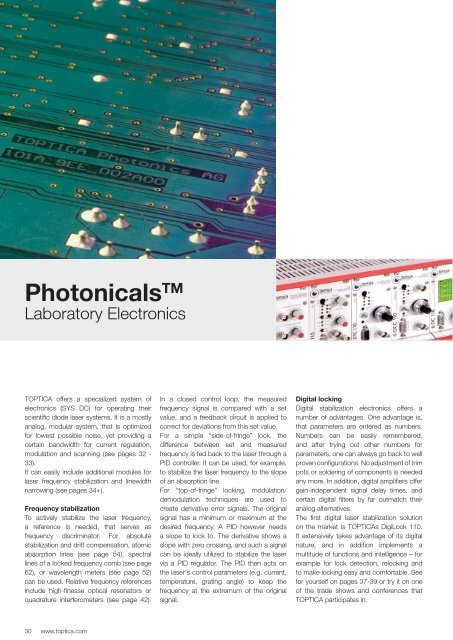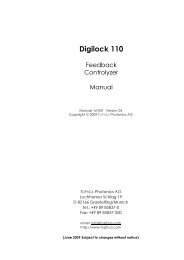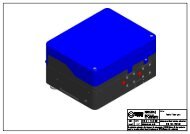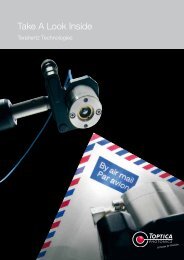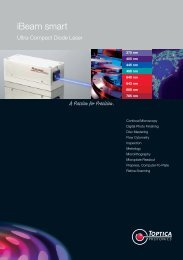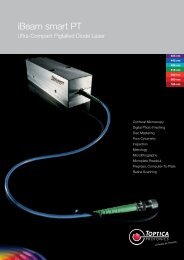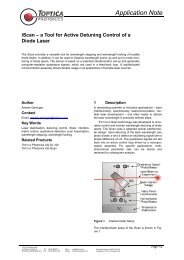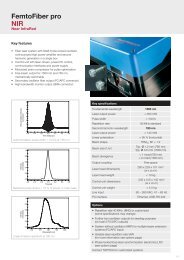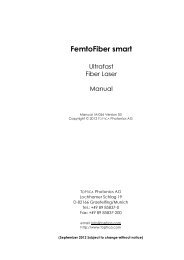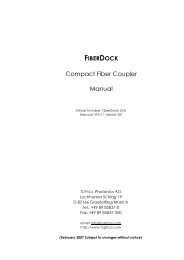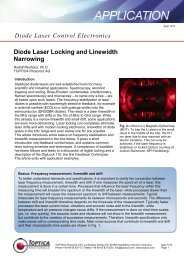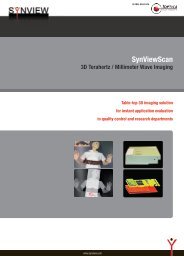pro - Toptica
pro - Toptica
pro - Toptica
You also want an ePaper? Increase the reach of your titles
YUMPU automatically turns print PDFs into web optimized ePapers that Google loves.
Photonicals TM<br />
Laboratory Electronics<br />
TOPTICA offers a specialized system of<br />
electronics (SYS DC) for operating their<br />
scientifi c diode laser systems. It is a mostly<br />
analog, modular system, that is optimized<br />
for lowest possible noise, yet <strong>pro</strong>viding a<br />
certain bandwidth for current regulation,<br />
modulation and scanning (see pages 32 -<br />
33).<br />
It can easily include additional modules for<br />
laser frequency stabilization and linewidth<br />
narrowing (see pages 34+).<br />
Frequency stabilization<br />
To actively stabilize the laser frequency,<br />
a reference is needed, that serves as<br />
frequency discriminator. For absolute<br />
stabilization and drift compensation, atomic<br />
absorption lines (see page 54), spectral<br />
lines of a locked frequency comb (see page<br />
62), or wavelength meters (see page 52)<br />
can be used. Relative frequency references<br />
include high-fi nesse optical resonators or<br />
quadrature interferometers (see page 42).<br />
30 www.toptica.com<br />
In a closed control loop, the measured<br />
frequency signal is compared with a set<br />
value, and a feedback circuit is applied to<br />
correct for deviations from this set value.<br />
For a simple “side-of-fringe” lock, the<br />
difference between set and measured<br />
frequency is fed back to the laser through a<br />
PID controller. It can be used, for example,<br />
to stabilize the laser frequency to the slope<br />
of an absorption line.<br />
For “top-of-fringe” locking, modulation/<br />
demodulation techniques are used to<br />
create derivative error signals. The original<br />
signal has a minimum or maximum at the<br />
desired frequency. A PID however needs<br />
a slope to lock to. The derivative shows a<br />
slope with zero crossing, and such a signal<br />
can be ideally utilized to stabilize the laser<br />
via a PID regulator. The PID then acts on<br />
the laser's control parameters (e.g. current,<br />
temperature, grating angle) to keep the<br />
frequency at the extremum of the original<br />
signal.<br />
Digital locking<br />
Digital stabilization electronics offers a<br />
number of advantages. One advantage is,<br />
that parameters are entered as numbers.<br />
Numbers can be easily remembered,<br />
and after trying out other numbers for<br />
parameters, one can always go back to well<br />
<strong>pro</strong>ven confi gurations. No adjustment of trim<br />
pots or soldering of components is needed<br />
any more. In addition, digital amplifi ers offer<br />
gain-independent signal delay times, and<br />
certain digital fi lters by far outmatch their<br />
analog alternatives.<br />
The fi rst digital laser stabilization solution<br />
on the market is TOPTICAs DigiLock 110.<br />
It extensively takes advantage of its digital<br />
nature, and in addition implements a<br />
multitude of functions and intelligence – for<br />
example for lock detection, relocking and<br />
to make locking easy and comfortable. See<br />
for yourself on pages 37-39 or try it on one<br />
of the trade shows and conferences that<br />
TOPTICA participates in.


